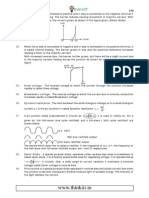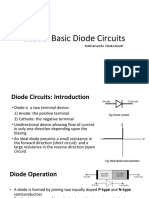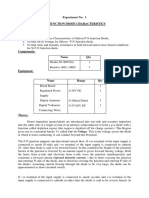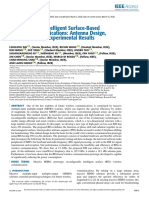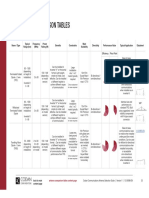ASSIGNMENT HNEE 19
TASK 01
Part (a)i
1
�2
�3
�Part (a)ii
4
�Part (a)iii & iv
5
�Part (b)i
6
�Part (b) ii
7
�8
�Part (c.)
9
�10
�Part (d)i
11
�12
�13
�14
�Part d (ii)
We simulate the circuit on multisim live you can find this simulation at
https://www.multisim.com/content/A7sPJEmTcGqDohv7pNrVFo/task-01-part-d/open/
Part d (iii)
Simulated results and calculated results are nearly equal but not same. This is because error due
to hand made calculations and round off errors.
15
�TASK 02
Part (a)i
16
�Part (a)ii
Part (a)iii
17
�Part (a)iv
Part (a)v
18
�Part (a)vi
Part (a)vii
19
�Part (b)i
20
�Part (b)ii
Part (b)iii
21
�22
�Part (b)iv
Part (b)v
Part (c)i
23
�Part (c)ii
Part (c)iii
24
�Part (c)iv
Part (c)v
25
�Part (c)vi
TASK 03
Part (a)
If the current flows naturally in one direction through a diode, then this is referred to as forward
biassing. If the current flow is reversed, this is referred to as reverse biassing. If the current flow
is natural in both directions, then this is referred to as reverse biassing.
When reverse biassing a diode, despite the high voltage that is applied across it, there is no
significant current flowing through it. Additionally, having this particular attribute is
advantageous when switching from alternating current to direct current. current (DC).
Among the many applications for which this capability could be put to good use is the control of
electronic signals.
26
�Characteristics Curve
27
�Part (b)
Simulate this part on multisim live, you can access this circuit from the following link
https://www.multisim.com/content/f2xZ7kQyNMEyqaGyQVrGh8/task-03-part-b-1/open/
(ia)
1a. Forward Bias
Vs (V) VD (V) ID (mA)
0 0 0
0.5 0.49 0.0024
1 0.66 1.52
2 0.7 5.9
4 0.72 14.89
6 0.74 23.92
8 0.75 32.97
10 0.751 42.037
15 0.76 64.714
1b. Reverse Bias
Vs (V) VD (V) ID (mA)
-5 -0.73 -19.4
-10 -0.75 -42.03
-15 -0.76 -64.714
(ib)
28
� Forward Bias
70
64.71
60
50
Diode Current in mA
40
30
20
10
0
0 0.1 0.2 0.3 0.4 0.5 0.6 0.7 0.8
Diode Voltage in Volts
Reverse Biased
0
-0.77 -0.76 -0.76 -0.75 -0.75 -0.74 -0.74 -0.73 -0.73
-10
-20
Diode current in mA
-30
-40
-50
-60
-64.71
-70
Diode voltage in Volts
(ic)
When we see the diode forward and reverse biased characteristics, voltage and current values are
same in Forward and reverse biased but only sign are opposite in both cases. It means, diode
worked in same way only current and voltage direction will reverse if we reverse the biased of
the diode.
29
�(iia)
Simulate this circuit in Multisim live, you can easily access this circuit using following link
https://www.multisim.com/content/8Aon8w5WRm2hVF96VmkYtC/task-3-part-b2/open/
Zener diode data
Vin (V) Vout (V) Iz (mA)
0 0 0
2 1.99 0.399
4 3.99 0.799
6 4.94 1.05
8 4.96 3.03
10 4.97 5.02
12 4.98 7.02
14 4.984 9.01
(iib)
Zener diode Characteristics
10
9 9.01
8
7
Zener current in mA
6
5
4
3
2
1
0
0 1 2 3 4 5 6
Zener Voltage in Volts
Part (c)iii
a & b’
30
�Simulation of this circuit is done by using Multisim live, we can access this circuit from the
following link
https://www.multisim.com/content/FEWr875LdoKQoGTz93AVD4/task-3-biii/open/
Vout (V) Vout (V) IB (mA) IC (mA)
Vin is 0 Vin is 10 Vin is 10 Vin is 10
Measurement 9.9 0.83 0.091 9.16
As we can see in results table when base voltages are zero the output voltages are maximum and
when base voltages are 10V then output voktages are minimum and base current is also
minmum, while collector current is higher than base current.
Part (c)
Diode operation
This bridge rectifier rectifies the input voltage by the employment of diodes in the way
illustrated in the figure. As a result, the diode is a unidirectional device, meaning that current can
only travel in one direction through it. Because of this restriction on the power output of the
diodes, it is not possible to change the power output of the rectifier while utilising this particular
configuration of transistors.
Zener Diode operation
When subjected to a wide range of load current conditions, it is possible to create a voltage
output that is steady and has low ripple by utilising Zener Diodes. By flowing only a tiny amount
of current through it from an external voltage source, through an adequate current limit resistor,
as shown in Figure 1, the desired voltage drop of Vout can be maintained while the zener diode
is being used.
Bipolar Transistor Operation
The power of a weak signal is increased by combining it with multiple signals of equal strength,
which is accomplished through the use of a transistor. The DC bias voltage given to the emitter
31
�base junction allows it to maintain its forward biassed state... This results in a big output voltage
from a little voltage given to the transistor, demonstrating that the transistor is capable of
operating as a voltage amplifier.
Part (d)
Bipolar transistor
Three different types of semiconductors can be stacked together to form a three-terminal
electrical device when they are layered together. If you have a big current flowing between the
emitter and collector terminals, you can utilise the base terminal to regulate it by passing a little
current through the base terminal. NPN transistors contain two current flows: a base-emitter
current flow and a collector-emitter current flow. These current flows manage and regulate the
flow of current. PnP transistors have control current from the emitter to the base, whereas bipolar
transistors have control current from the emitter to the collector.
Applications
Amplification of signals
Switching
In digital circuits.
High voltage switches
Radio-frequency amplifiers
Switching heavy currents.
FET Transistor
In this case, the control voltage is received by the gate, which is isolated from the other two
terminals on the chip by a channel that has been included into the chip. However, although this
diagram is an excellent introduction to field-effect transistor (FET) operation, it depicts a device
known as a junction field-effect transistor (JFET), which is a relatively unique technology in the
semiconductor industry (JFET). Metal oxide semiconductors, which are a type of semiconductor,
are utilised to construct the vast majority of field-effect transistors now in use today
(MOSFETs). The insulating layer that separates the gate and channel of a MOSFET prevents the
gate and channel from coming into contact with one another. The result is that current flow
32
�across the channel can be varied by adding a voltage, in contrast to a bipolar transistor, which
must have a constant input current in order to work. This figure displays an n-channel MOSFET,
also known as an NMOS transistor, which operates in the presence of an n-channel MOSFET.
NMOS transistors have electrons as the predominant carriers, whereas p-channel MOSFETs and
PMOS transistors have holes as the predominant carriers, as seen in the diagram.
Application
Used in mixer circuits to control low inter modulation distortions.
Used in low frequency amplifiers
Used in operational amplifier
Voltage variable resistors.
TASK 04
Part (a)
All electrical devices are classified as either analogue or digital. Consider a clock and a watch to
best explain the distinction between analogue and digital devices. On a classic analogue clock,
the hands indicate the current time by pointing to a specific spot on the dial. As illustrated in the
figure below, a digital clock's numeric display indicates the precise time.
Analogue circuitry is defined by a constant rate of voltage or current variation over a lengthy
period of time. For instance, rotating a potentiometer dial alters the resistance at a steady rate
over time. According to the potentiometer's specifications, its resistance can be any value
between the smallest and greatest values permitted.
By connecting a fixed resistor in series with a potentiometer, a voltage divider may be created,
resulting in a smooth increase or decrease in voltage as the potentiometer knob is adjusted.
Digital electronics, in contrast to analogue electronics, operates on a count rather than a
measurement. In mathematics, there is a significant distinction between counting and measuring.
When something is counted, an accurate result can be obtained. When you measure anything,
you obtain a close estimate of the true value.
33
�Two cups flour, one cup milk, and two eggs are included in a cake recipe that includes all of the
above. This recipe calls for one and a half dozen cups of dry ingredients (flour) and two and a
half dozen cups of wet ingredients (milk, oil, and eggs). 1 cup milk, halfway filled in a liquid
measuring cup, added to a mixing bowl and stirred until the milk was completely absorbed into
the batter. For two eggs, crack two eggs open in a mixing dish along with the remaining
ingredients.
In this recipe, flour and milk are rounded to the nearest cup. It makes no difference whether you
use one or two teaspoons. Despite this, the eggs are accurately counted: there are two of them.
Not three, not even one, but two. There is no such thing as too many or too few eggs in a diet.
There will be two eggs as a result of your counting.
The question is which is more precise, analogue or digital. Analogue circuits are imprecise in
comparison to digital circuits, which can only count to a finite precision. When it comes to
counting jelly beans, utmost precision is required.
On the other side, an analogue scale may give you incorrect readings because you cannot always
tell exactly where the needle is in the jar. Consider the following scenario: The scale reads
between 4 and 5 pounds. This question has two distinct answers. Your best estimation is
approximately 4.5 pounds, as the scale does not provide an accurate reading.
Because digital circuits must count in predefined units, they are inherently less exact than their
analogue equivalents. Digital thermometers, for example, which are frequently found on
refrigerators, frequently display only one digit. As a result, they are capable of displaying 98.6 or
98.7 degrees Celsius, but not 98.65 degrees Celsius.
Part (b)
Many different types of amplifiers can be classified based on the qualities of their inputs and
outputs and the way they interact with one another. Multiplying a property of the output signal
by a quantity referred to as gain illustrates the link between its magnitude and that of the input
signal. Voltage gain may be described as a ratio of a device's current to its output voltage, or it
may be defined as a ratio of its output power to its input power (current gain, voltage gain,
power gain). It is common to express gain in terms of decibels (dB) since the variable property of
34
�the output is often dependent on the same variable value of the input, despite the fact that it is
generally expressed in unitless.
Linear amplifiers are the most common type of amplifier. Each common combination of input
level and output signal is maintained at a constant gain. If the gain of an amplifier is not constant,
the output signal can become distorted. Despite the fact that variable compensation can be
advantageous in some situations, it is not always the case. A signal processing device known as
an exponential gain amplifier is useful in a wide range of situations.
It is common for an amplifier to be developed for a specific use, such as radio and television
transmission and reception, high-fidelity stereo equipment, microcomputers and other digital
equipment, guitar and other instrument amplifiers, among many others. Amplifiers must have at
least one active component in order to function properly.
Part (c)
NOT gates (also known as NOT-AND gates) are logic gates in digital electronics that produce an
output that is false only if all of their inputs are true; as a result, their output is the complement of
that produced by an AND gate. NAND gates are also known as NOT-AND gates. Any of the
gate's inputs can be set to LOW(0), and if all of the gate's inputs are set to HIGH(1), a HIGH (1)
output will be produced. If any of the gate's inputs is set to LOW(0), a HIGH (1) output will be
produced.
Truth Table
A B Y1A Y1B Y2 Y3
0 0 1 1 0 1
0 1 1 0 1 0
1 0 0 1 1 0
1 1 0 0 1 0
Part (d)
This logic function is known as NAND gate logic function
35
�Part (e)
Ones transferred in analogue mode need less bandwidth than signals transmitted in digital mode.
Compared to digital signals, signals obtained from analogue sources are more accurate
representations of changes in physical phenomena such as the presence or absence of sound,
light, temperature, location, or pressure. When it comes to electrical tolerance, analogue
communication systems are more forgiving than digital communication systems, which are more
forgiving yet.
A few advantages of using digital signals, such as those produced by digital signal processing
(DSP), as well as those produced via communication systems, are as follows: Digital signals
enable information to be conveyed with less noise, distortion, and interference than analogue
signals. The replication of digital circuits in large quantities at a reasonable cost is possible at a
lower cost than the replication of other types of circuits. As well as other electronic gadgets such
as computers and information appliances, digital cameras and digital televisions, flash memory,
key USB memory, mobile phones, hard discs, and devices for computer memory, there are many
additional types of devices that fall into this category. Following the conversion of analogue
signals to digital form, the signals are subjected to digital signal processing to improve their
quality.
Part (f)
Analog electronics is a branch of electronics that deals with signals that are constantly changing
in nature, such as those produced by radio waves. Radio and audio equipment, as well as other
applications, in which signals originating from analogue sensors are changed into digital signals
for storage and processing after they have been converted, are examples of this type of
technology being used.
The use of digital audio systems is becoming increasingly common in a wide range of
applications. It is common practise to use digital audio systems in the post-production of
television shows and films. In addition, digital audio systems are employed in a range of
applications such as audio recording, automobile stereos, and sound reinforcement systems, to
name a few.
36






